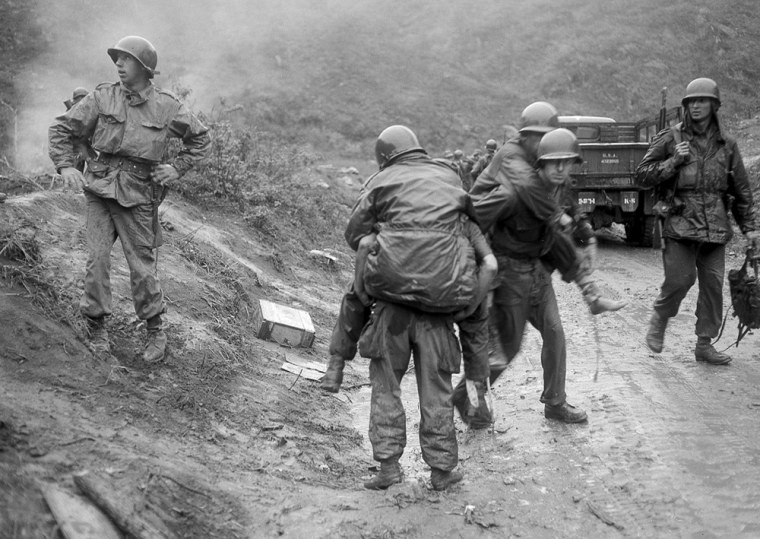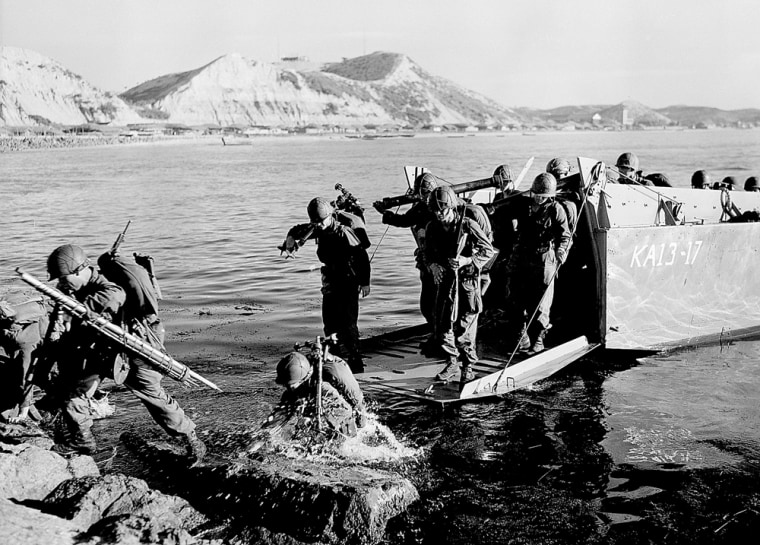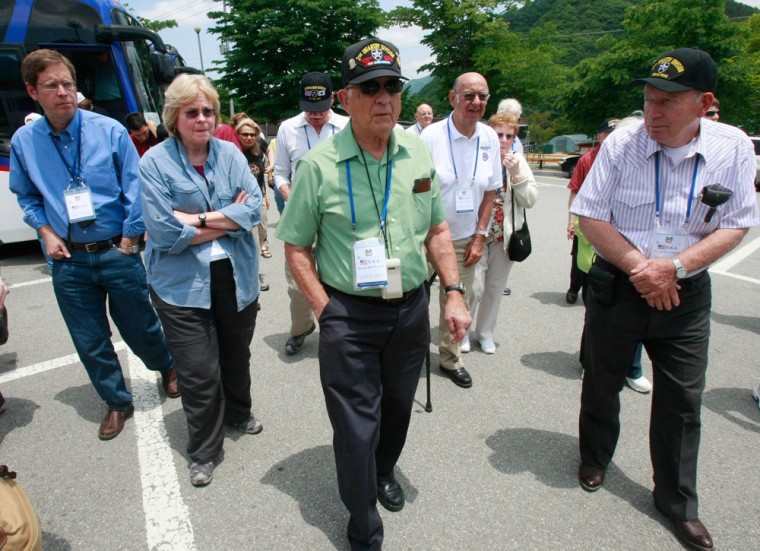The old soldier stood erect on the riverbank, his cane at his side, a baseball cap emblazoned "2nd Infantry Division" square above his brow. He looked out, then turned away from the slow, silty Naktong.
"I've seen this river before," Carroll Garland said. "I don't want to remember. Too many memories."
The war that began in Korea 60 years ago, on June 25, 1950, a ghastly conflict that killed millions and left the peninsula in ruins, became "The Forgotten War" in many American minds.
To a shrinking corps of aging men, however, the soldiers of Korea 1950-53, it can never be forgotten. It damaged many physically, scarred many mentally, and left men questioning their commanders' and their nation's wisdom.
They fought many enemies — not just the North Koreans and Chinese, but also the heat, the killing cold and the cursed hills, the thirst, hunger and filth, the incompetence and hubris of their own army, and the indifference of an American homeland still fixed on the "good" war, World War II, that had ended five years earlier.
Remembering Korea today may be painful, as ex-sergeant Garland, 81, of Oxon Hill, Maryland, can attest. But when such men get together, the freeze frames of war's horrors and miseries, of lost comrades and paralyzing dread, inevitably emerge in sharp focus.
"At the reunions, they talk about it," said Lucille Macek, 76, wife of Shawnee, Kansas, veteran Victor Macek. "And then they break down."
In a wartime arc of desperation, triumph, retreat and final stalemate in Korea, no U.S. division sacrificed as much as the 2nd Infantry Division, losing more than 7,000 killed, one-fifth of total U.S. dead. And it is the 2nd Infantry Division that still stands guard over South Korea today.
Two days spent with a "2nd ID" group on a 60th-anniversary visit to old battlefields opened a window on the men and events of a lifetime ago, when what happened here, on the Naktong, on the Chungchon River of North Korea, in places like Kunu-ri and Heartbreak Ridge, neglected stories though they may be in today's textbooks, was nothing less than a pivotal turn in 20th-century history, when a cold war grew hot in America's confrontation with communism.
'Things were desperate
"We didn't have enough men," Henry Reed recalled of the division's ordeal on the Naktong.
"There were so many holes in the line, the North Koreans didn't have to try too hard. The enemy would get behind us, and we'd be fighting on all sides. Things were desperate."
It was called the Pusan Perimeter, a southeastern corner of Korea running 85 miles north to south along the Naktong, and 60 miles east to west. Here in mid-1950, in one of the most perilous U.S. military operations ever, outmanned U.S. and South Korean troops mounted a last-ditch defense against a closing North Korean vise.
It wasn't supposed to be that way. After the communist-led northerners struck south in their surprise invasion on June 25, two years after U.S. combat units withdrew from South Korea, U.S. commanders believed the simple reappearance of American troops would deter the North Koreans.
"At our base in Hawaii, we thought the war would be over and we wouldn't get our Combat Infantryman's Badges," said Marvin House, 79, a veteran of the 5th Regimental Combat Team (RCT). "Boy, were we fooled."

The northern army battered the first-arriving U.S. units and shattered the South Korean divisions. It simply was better trained and better equipped, with Soviet-made T-34 tanks.
The U.S. government had shrunk the Army drastically after World War II, and training and equipment upgrades were neglected.
As the 2nd Division sailed from Ft. Lewis, Washington, toward Korea in late July 1950, "we wound up training our soldiers to fire their weapons at tin cans thrown into the Pacific," said retired Col. Ralph M. Hockley, 84, of Houston, then a young artillery officer.
"Twenty percent of our vehicles had to be towed to the embarkation point," Walter Wallis of Palo Alto, Calif., recalled of the 2nd Division deployment. "We had some real crap, four-year-old C-rations and stuff like that."
Not long after, on the Naktong, the 18-year-old radioman Wallis watched helplessly from a hilltop as a U.S. river-crossing patrol was slaughtered by the North Koreans. His batteries had failed; he couldn't call for help.
No ammo
For House, a 57mm-recoilless rifleman, it wasn't quality but the quantity: none. For a month after his 5th RCT took up position on the perimeter, he had no ammunition for his gun, leaving him to help mortar and other gun crews fight off the enemy.
The North Koreans, crossing the shallow Naktong at night on barges or over underwater "bridges" built of rice bags filled with rocks, hammered again and again at the U.S. and South Korean lines in August and early September 1950.
The "lines" were more a series of hills, road junctions and other points manned by under-strength units, sometimes a mile apart. Commanders would rush up reserves to fill the gaps as the North Koreans attacked.
For the GI, in the 100-plus-degree heat, amid tropical downpours and malarial mosquitoes, with water supplies scarce, soldiering became misery. "Those weeks seemed like a lifetime," said House, of Bonne Terre, Missouri.
Time and again, the 2nd and other U.S. and South Korean divisions held the North Koreans off, sometimes fighting hand-to-hand, at great cost to the defenders and even greater cost to the North Koreans. Finally, on Sept. 15, 1950, U.S. amphibious forces landed at Inchon, far to the North Koreans' rear, cutting them off from their supplies and recapturing Seoul from the invaders.
That set off a race north by the Pusan Perimeter divisions, a "breakout" whose momentum carried them by November to the Yalu River and the North Korean-Chinese border, as overall commander Gen. Douglas MacArthur and the U.S. leadership sought to conquer North Korea.
"We did what we had to do. We kept them out," twice-wounded ex-rifleman Reed, 78, of Butte, Montana, said of the Naktong campaign. "But we suffered plenty. In the first month, my company" — A Company, 23rd Infantry Regiment — "went down to 78 men from 200."
More suffering lay ahead. The lunge north had been ill-conceived, putting the American army on a collision course with the might of China deep inside North Korea.
Retired Lt. Col. Lynn A. Freeman, then a lieutenant at 23rd Infantry headquarters, remembered the night in late November 1950 when a Chinese attack materialized from nowhere, "blowing bugles and whistles and making a lot of noise," and penetrating into the regimental command post at the Chungchon River.
The regiment's 1st Battalion beat them back. "The bodies of wounded Chinese were frozen in the river's ice the next morning," recalled the quiet-spoken Freeman, 87, of Concord, Calif. Meanwhile, young Wallis had an image frozen in his memory, of panicked U.S. soldiers trapped in sleeping bags and hopping down a hillside to escape the Chinese.
"The next day we went up there and saw a couple that didn't make it," he said.
The Gauntlet
But Chinese attacks all along the front forced the longest retreat in U.S. military history, a withdrawal by the entire U.S. Eighth Army some 160 miles back into South Korea.
For the 2nd Division, the pullback through Kunu-ri and the valley remembered as "The Gauntlet" was a descent into a wintry hell.
"It was sleepwalking, day and night marching, when the Chinese came in," remembered Rudy Ruiz, 77, of Las Vegas, a 38th Infantry Regiment rifleman.
Miles-long convoys of trucks, tanks and men pushed south under heavy fire from Chinese dug into the hills on both sides, fire that crippled vehicles, blocked the narrow roadway, stranded knots of doomed men. In a single day, the division lost 3,000 killed, wounded or missing.
Even for those who escaped, the frigid temperatures and biting Siberian wind of an early winter could be as deadly an enemy. Wounded men froze to death while waiting for help. Hundreds suffered frozen feet and fingertips, noses and ears. The Army had failed to deliver winter clothing to tens of thousands of troops.
"The worst was the cold. I've never been so cold," said Ruiz. "You'd dig a hole in the snow and you'd all huddle together."

The "Big Bugout" retreat left the Eighth Army holding a line below the 38th Parallel, the North-South divide.
In February 1951, the Chinese mounted an all-out offensive, but were turned back at Chipyong-ni by the 2nd Division, ushering in a final long phase of the Korean War, the "war of the ridgelines," as the two sides jockeyed for advantage, winning hills, losing them, winning them back, while truce talks went on.
It was at Heartbreak Ridge, in September 1951, that "we got into trouble, when we tried to move north," recalled Ed Reeg, ex-machine gunner with the 23rd Infantry. "The night of 19 September, Love Company was under real heavy attack, and Lt. Monfore called for a machine gun."
Reeg climbed to Love's position, set up his .30-caliber gun, and suddenly the North Koreans were charging out of the darkness along the ridgeline. Reeg's team tried to hold them off, dodged their grenades, but finally "they found the mark," a bullet hitting him above the hip, sending him rolling in pain.
As Love beat back the attack, at the cost of Lt. Monfore's life, Reeg was carried to a spot on the hillside, injected with morphine, roughly bandaged, and left lying there, as the sun rose, peaked and began to set.
"Here I'm thinking, it's over. What's my mom going to think?" In late afternoon, passing GIs realized he wasn't dead and sent him off to a medical station. The war was over for Ed Reeg, who would be awarded a Silver Star for bravery.
Too many memories.
This May 31, Reeg, 82, of Dubuque, Iowa, stood with his wife and son atop a ridgeline south of Korea's dividing Demilitarized Zone, and looked out toward Heartbreak.
"To think we were so close to where I lay dying 59 years ago," he reflected later. "I never thought I'd get back here."
It wasn't the only pilgrimage this old soldier has made. In 2003, he found Lt. Peter Monfore's grave in Springfield, South Dakota, and met with his family. "It seemed like my duty to go find him."
Duty and doubts, flashbacks and nightmares, pride and uncertainties — veterans of killing fields, in Korea or elsewhere, are often torn by conflicting feelings. Many Korea vets are open about the psychic legacy of their war.
"I had night sweats for years," Ruiz said. "Whatever, it's still blocked out." Reeg believes a nervous breakdown he suffered in 1960 may have stemmed from his time in Korea.
In their foxholes 60 years ago, many questioned why their lives were being risked in a far-off civil war. "As a young fellow, I did wonder what we were doing here," said the big Montanan and ex-rifleman Reed.
Their anniversary tour supplied an answer for some, as they gazed upon a prosperous and — in recent decades — democratic South Korea, whose government subsidizes such veterans' visits.
"This makes me feel it was worth it," said Reeg. "To see this country built up. It's amazing."
They recognize the picture is incomplete, however, since the peninsula remains divided. "That's one thing I'm sorry for," said Reed.
Glad to be alive
In fact, John Manly long thought he would wait for Korean reunification before returning. Finally, at age 80, the old 23rd Infantry rifleman came, despite obvious misgivings about his war and its results — "I am almost a pacifist," he told a reporter.
Equally obvious, as he spoke of a wartime friend killed in action, was his love for his fellow soldiers.
"Isn't a day goes by I don't think about him," said Manly, of Saratoga Springs, N.Y. "I'm glad to be alive. A lot of the guys in there tonight are happy to be alive," he said, nodding toward a banquet hall filled with fellow veterans.
That evening it was Manly's tenor voice that silenced the hall, drawing the gray heads of old soldiers together in thoughts only they could share, as he sang, to the tune of the World War II favorite "Lili Marlene," lyrics someone had improvised in 1952 as their own war dragged on:
"When the war is over and the world is free,
We'll relive proud memories of bloody Kunu-ri.
Sayong and Heartbreak will be retold,
And Bloody Ridge will make us bold.
Our hearts will always be
With the 2nd Infantry."
